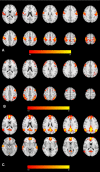Feasibility of Contrasting Brain Connectivity Patterns in Cognitive and Motor Cerebral Networks to Clinical Outcomes in Patients Surviving Acute Respiratory Failure: A Pilot Study
- PMID: 34659996
- PMCID: PMC8495532
- DOI: 10.7759/cureus.17785
Feasibility of Contrasting Brain Connectivity Patterns in Cognitive and Motor Cerebral Networks to Clinical Outcomes in Patients Surviving Acute Respiratory Failure: A Pilot Study
Abstract
Background: There is a paucity of research regarding the feasibility and association of cerebral cortex function to patient outcomes after acute respiratory failure (ARF).
Purpose: To determine the feasibility of functional connectivity measures and examine the association of functional connectivity to a multifaceted battery of outcomes in survivors of ARF.
Methods: Eight ARF patients (age:58±3.7, ICU days:10.4±8.6) completed functional magnetic resonance imaging (fMRI), cognitive, physical-function, anxiety, depression, and driving simulator tests at one month post-hospital discharge. Pearson's correlations assessed the relationship between functional connectivity within the default mode network (FPN), sensorimotor network (SMN), and frontoparietal network (FPN) to outcomes.
Results: Low physical-function (r=0.75, p=0.03) and divided-attention (r=-0.86, p=0.03) during the driving simulator task correlated with low FPN connectivity. Low SMN connectivity demonstrated relationships to slower gait speed (r=0.82, p=0.01) and low short physical performance battery (SPPB) scores (r=0.81, p=0.01).
Conclusions: fMRI is feasible to assess ARF patients' post-ICU limitations, as low post-ARF brain connectivity may be linked to low physical function, providing potential development of therapeutic interventions.
Keywords: cognition; mobility; multifaceted outcomes; neuroimaging biomarkers; post-icu brain connectivity.
Copyright © 2021, Morelli et al.
Conflict of interest statement
The authors have declared that no competing interests exist.
Figures
References
-
- Physical impairments associated with post-intensive care syndrome: systematic review Based on the World Health Organization's International Classification of Functioning, Disability and Health Framework. Ohtake PJ, Lee AC, Scott JC, et al. Phys Ther. 2018;98:631–645. - PubMed
-
- Potentially modifiable risk factors for long-term cognitive impairment after critical illness: a systematic review. Sakusic A, O'Horo JC, Dziadzko M, et al. Mayo Clin Proc. 2018;93:68–82. - PubMed
Grants and funding
LinkOut - more resources
Full Text Sources

